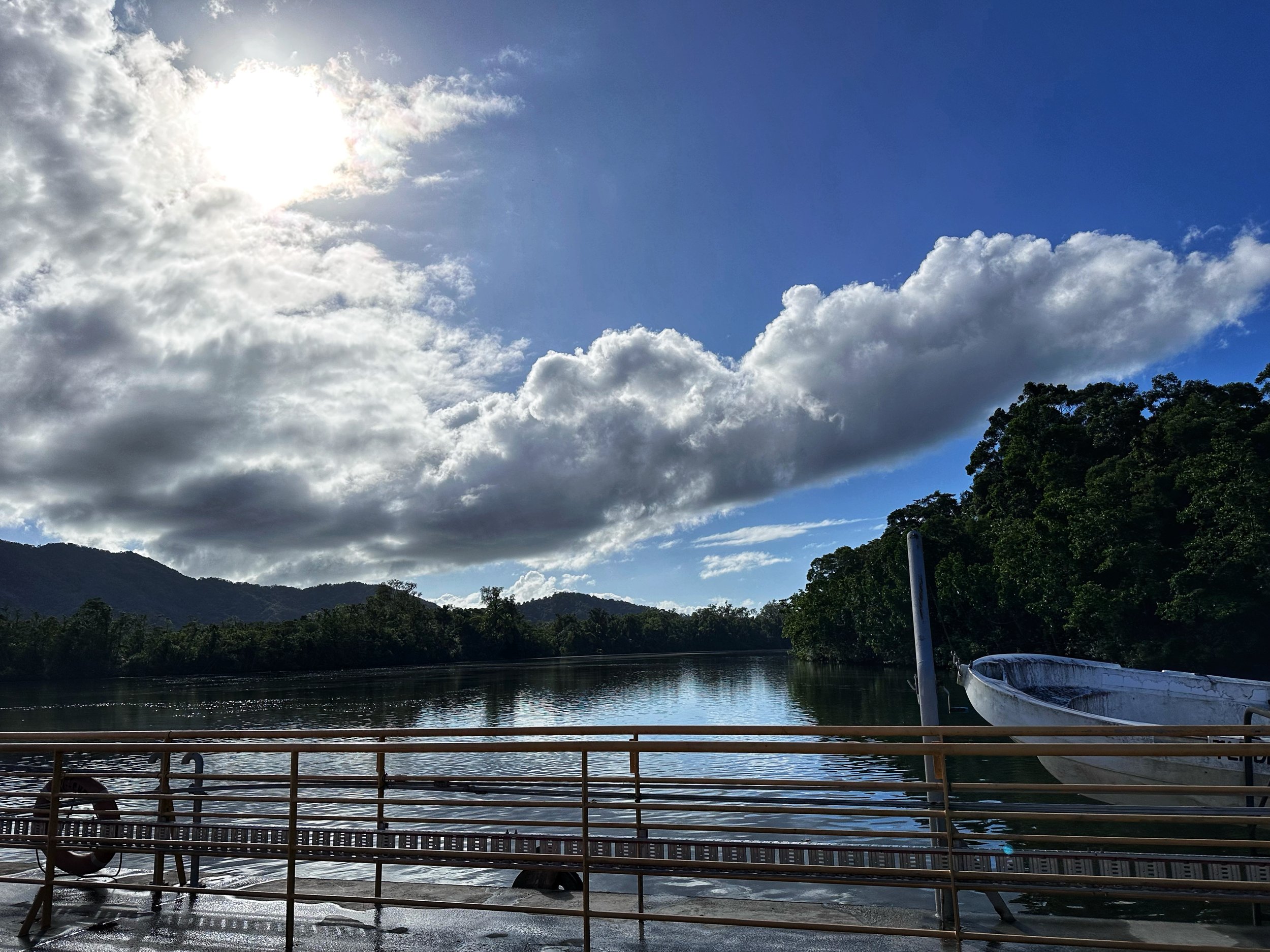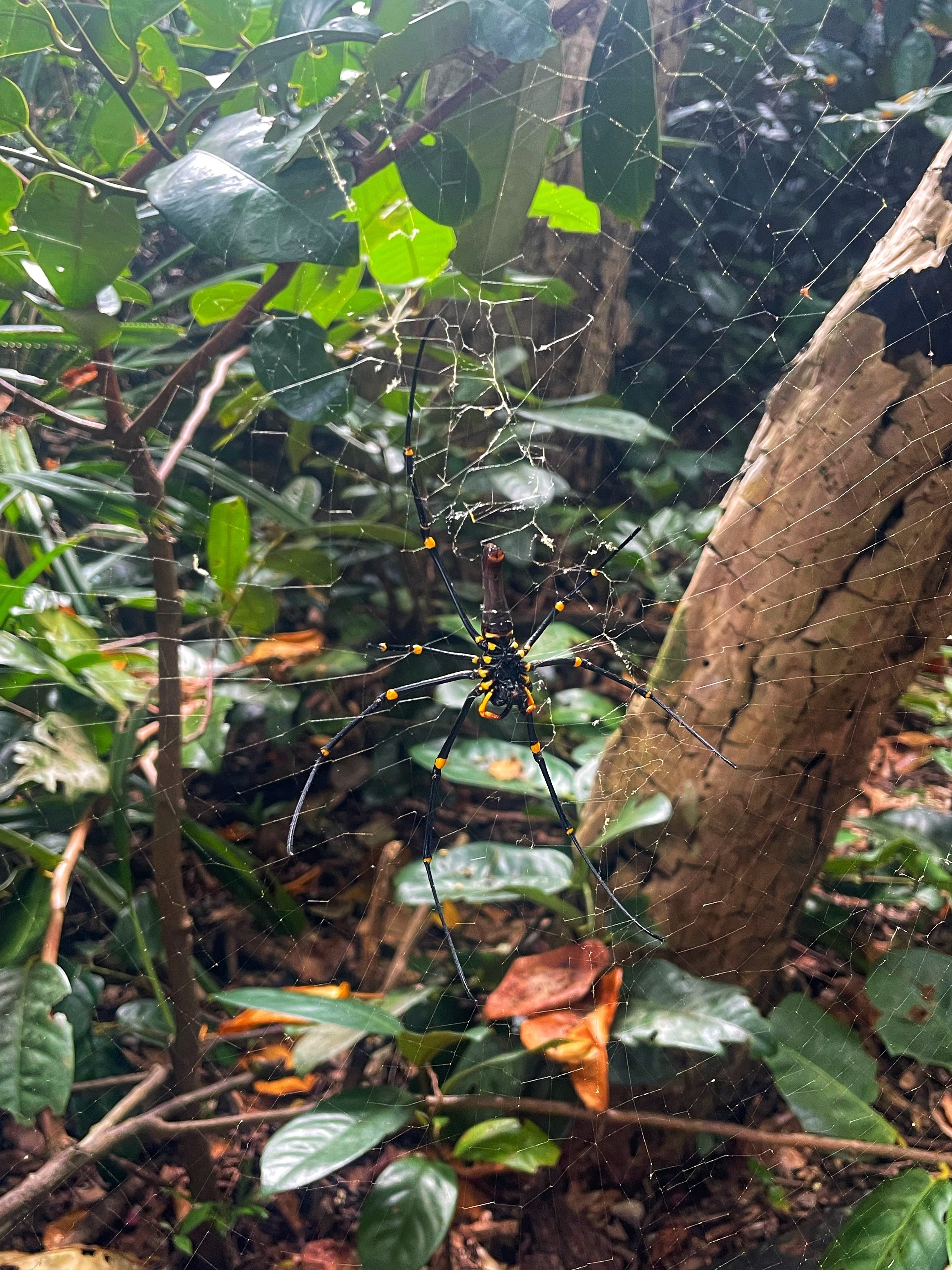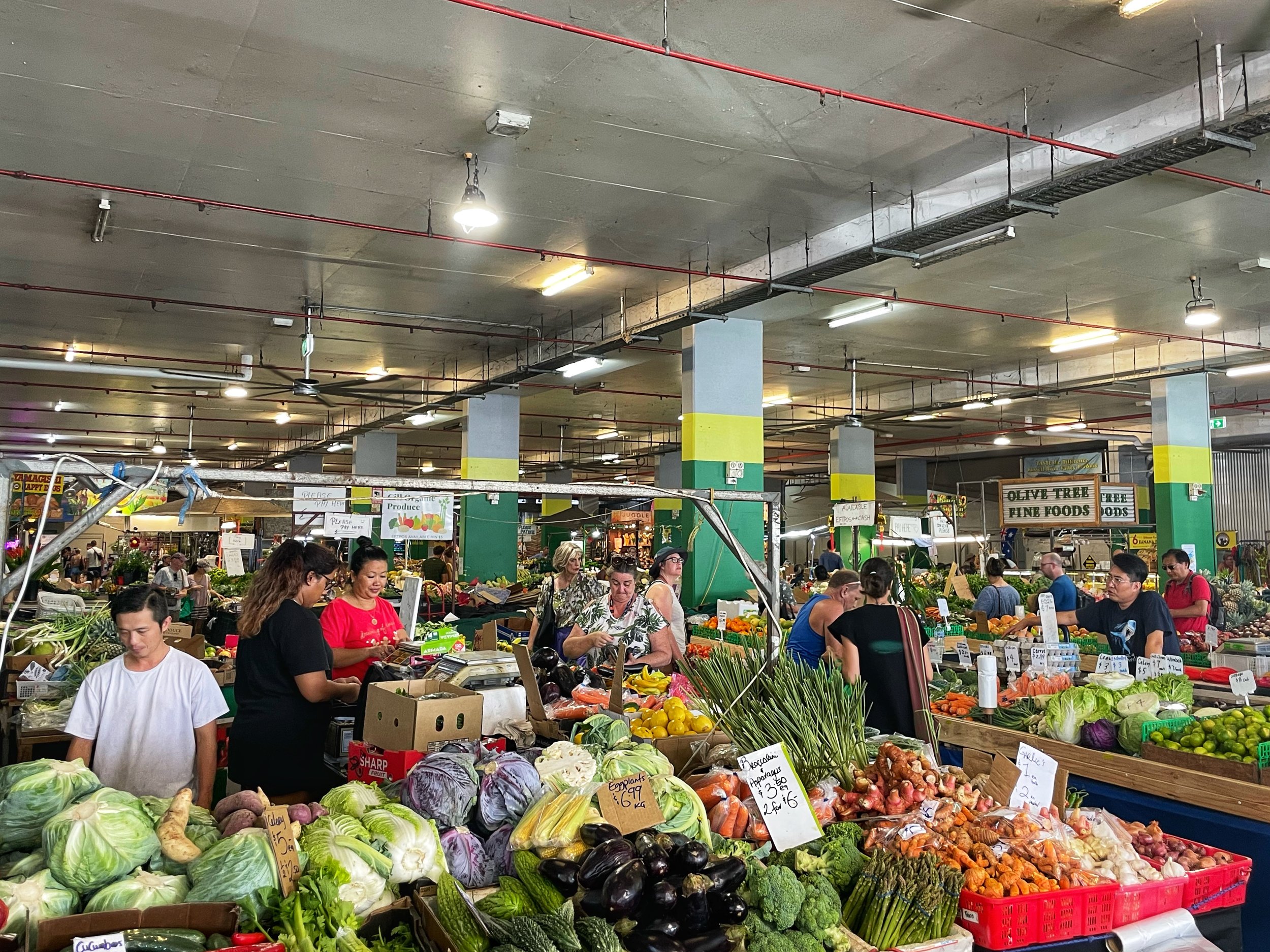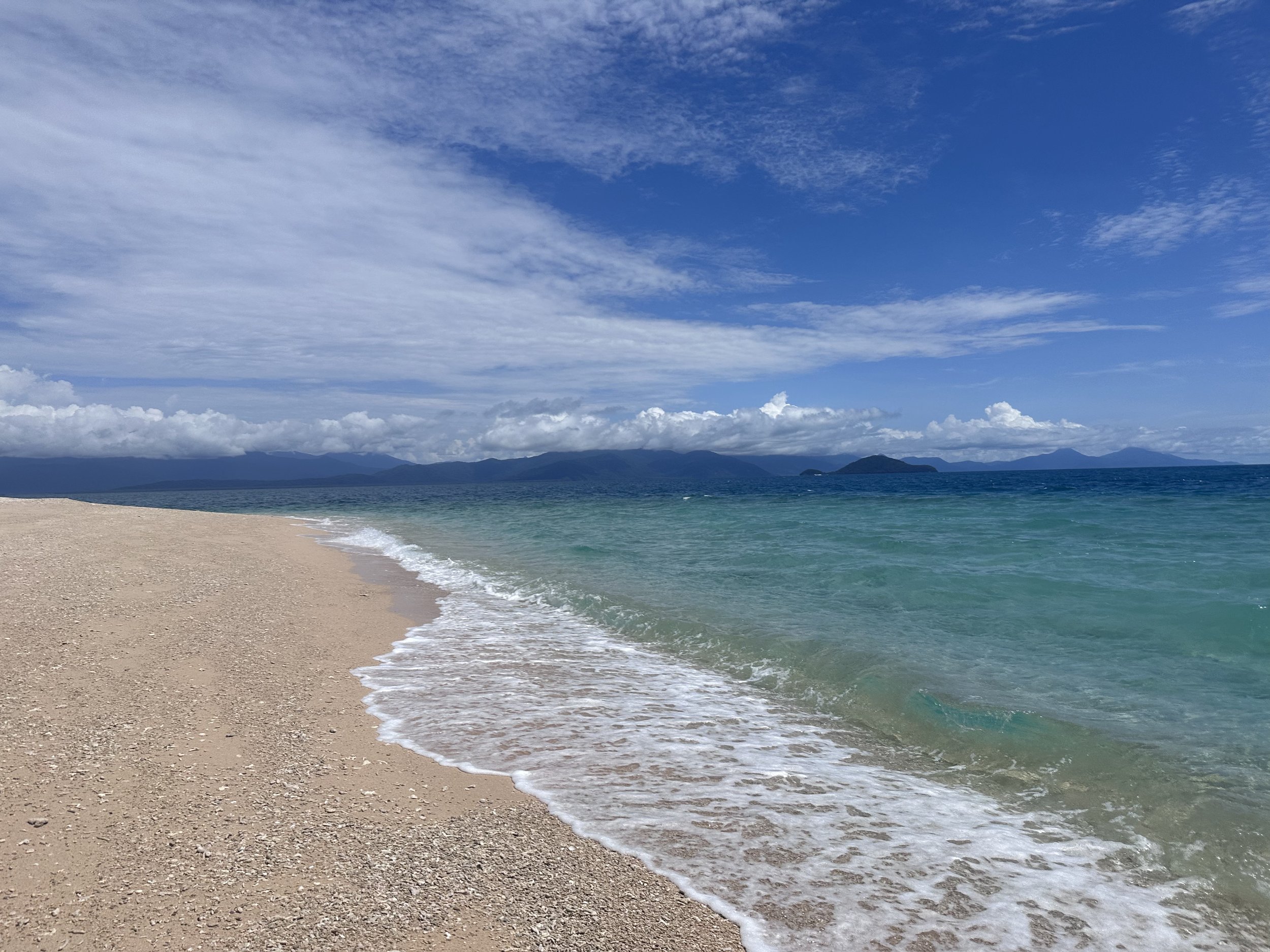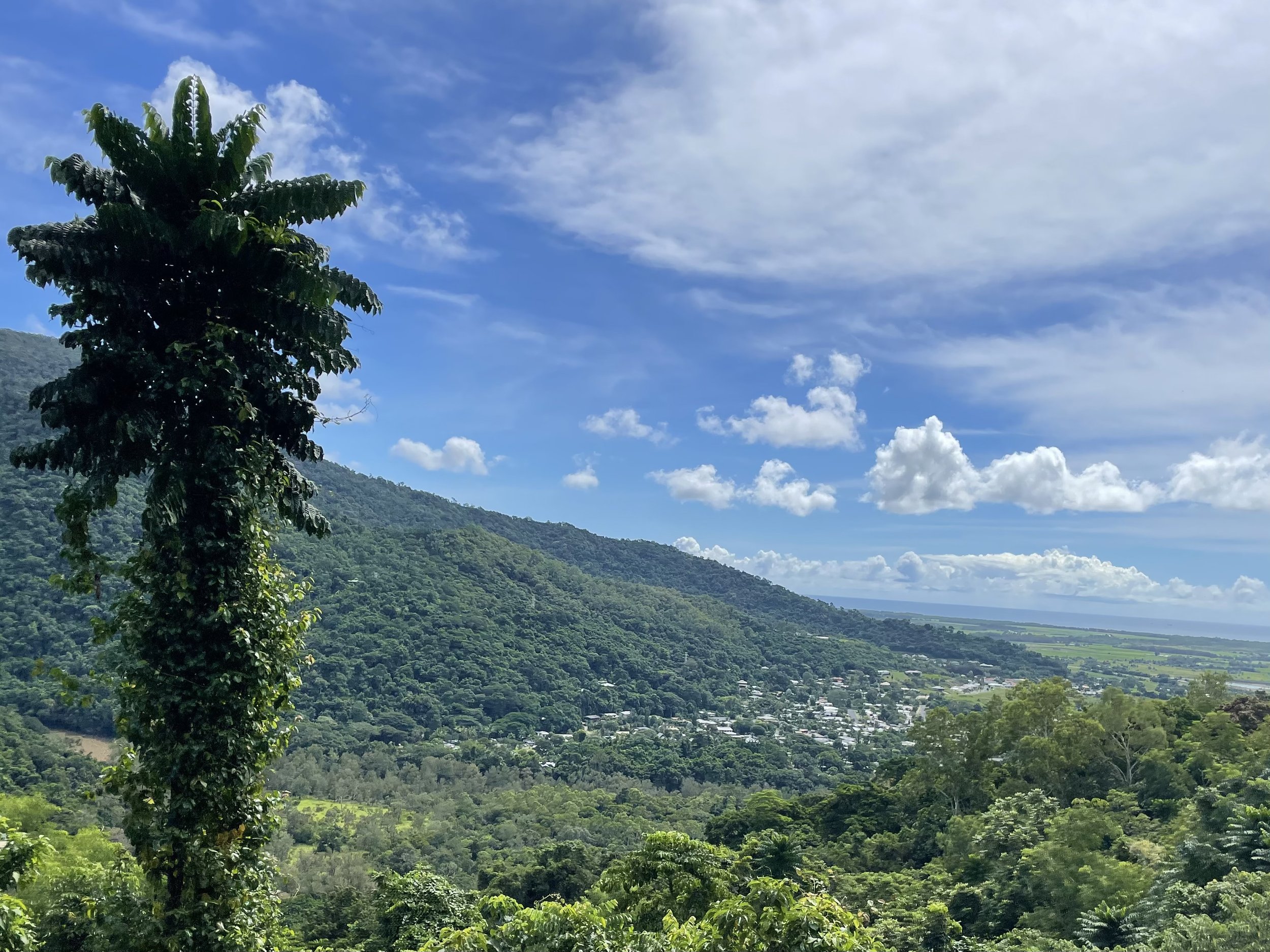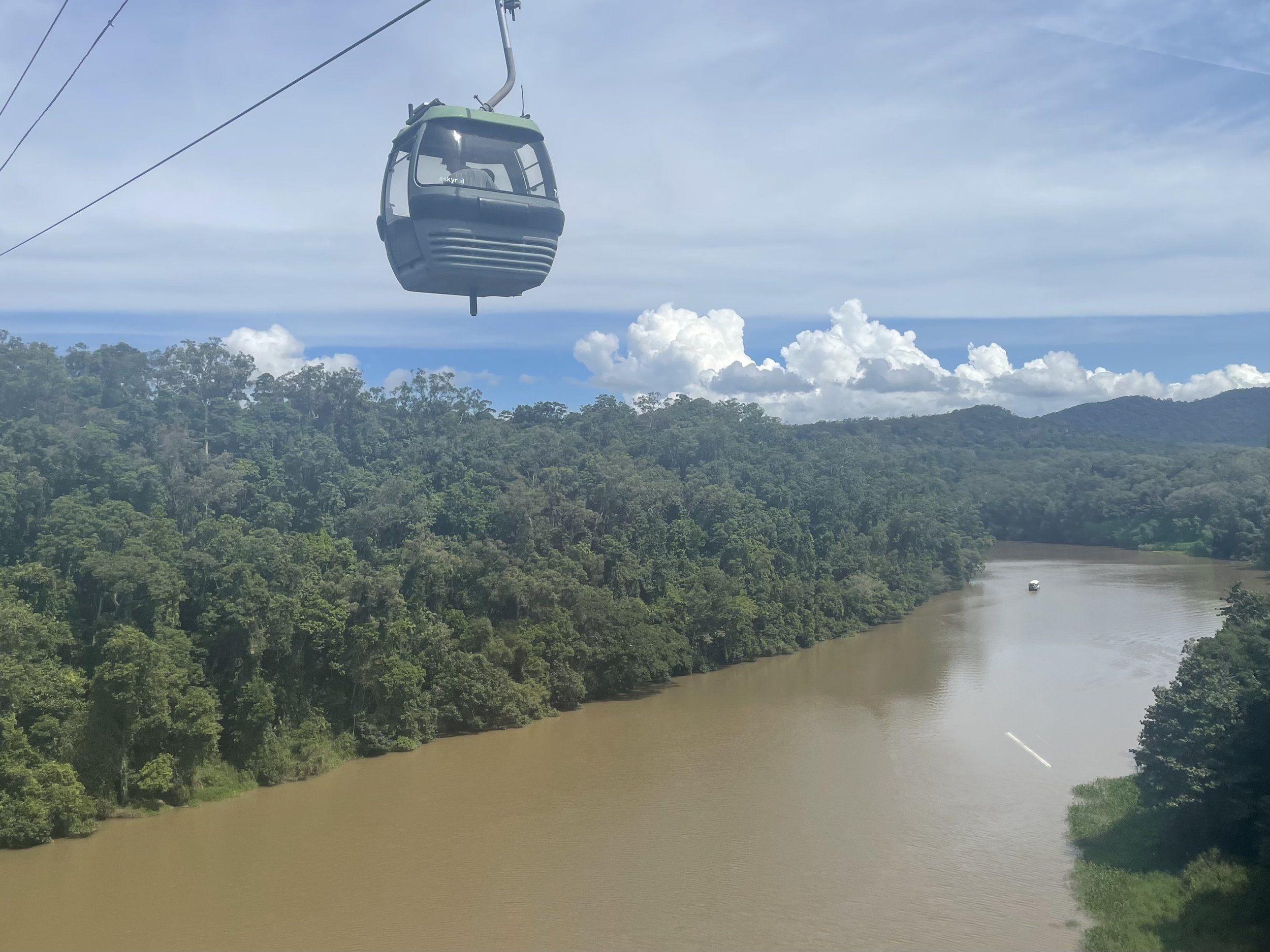Queensland, Australia
Highlights
Port Douglas
Daintree Rainforest
Great Barrier Reef - Agincourt
Trinity Beach
Cairns
Frankland Islands
Kuranda
Why visit Northern Queensland?
For the world’s oldest living rainforest, wonderful waterfalls, the Great Barrier Reef, and tropical beaches.
Getting there and around
From our accommodation in Brisbane we booked an Uber to the airport (cost - £40, time - 15 minutes).
We took a 2 hour domestic flight from Brisbane to Cairns with Virgin Australia.
We had booked a hire car with Apex at Cairns who are located close to the airport. On arrival we rang Apex who quickly collected us in a shuttle bus and took us to their hire car pick up location.
The customer service from Apex was friendly and efficient. The car (SUV, cost £100 per day) was ready and waiting in the shade, and booster seats were quickly fitted for the kids. We then drove to our accommodation in Port Douglas, 1 hour north of Cairns.
Northern Queensland is a tropical region with a dry season (May - October) and a wet season (October - May). We visited at the end of March. It was hot and humid but we were lucky with the weather as we had clear sunny days with only a little rain over night.
Accommodation
We decided to split our stay between Port Douglas and Trinity Beach. Staying at Port Douglas put us in easy reach of the Daintree Rainforest and the outer part of the Great Barrier Reef. Moving to Trinity Beach then had us closer to activities in and around Cairns.
Freestyle Resort, Port Douglas
First we stayed at the Freestyle Resort in Port Douglas for 5 nights. Freestyle consisted of around 30 apartments and an outdoor heated saltwater pool. The pool was one of the best we’ve had in Australia. It was warm, had plenty of shallow parts for the kids, and lots of shaded seating around.
We had a 2 bedroom apartment which cost £150 per night. Unfortunately the apartment was a little tired compared to the website photos, the wi-fi wasn’t reliable and we also experienced noise from a big group at the resort during our stay. So overall Freestyle had the potential to be fantastic but sadly it didn’t quite deliver for us on this occasion.
Our star rating: 3
Our cost rating: 3
Sea Change Apartments, Trinity Beach
After Port Douglas we moved hotels to Sea Change Apartments at Trinity Beach, 20 minutes drive north of Cairns. We stayed for 6 nights in a 2 bedroom swim-up apartment on the beach front for £200 per night.
The apartment was modern, clean and very spacious and came with loads of cooking equipment and laundry appliances. Our apartment had a patio with steps down into the pool which was lovely, and there was a great poolside BBQ area too. There was a rather noisy bunch of enthusiastic crows in the tree across the road who sounded like asthmatic bagpipe players. Otherwise it was gloriously quiet and peaceful.
Our star rating: 4
Our cost rating: 3
Port Douglas
Port Douglas is a coastal town about an hour’s drive north of Cairns. It’s an attractive town with fantastic local shops and restaurants. There is a marina and a beach (Four Mile Beach) which has a safety net to keep out lethal jelly fish (prevalent along this coastline during the wet season). Port Douglas was an ideal base for our day trips to the Daintree Rainforest and the Great Barrier Reef at Agincourt.
Daintree Rainforest
We set off early (7.30am) to beat both the heat and the traffic for our journey north of Port Douglas to the Daintree Rainforest national park.
We drove for 40 minutes to the ferry where we crossed the Mossman River with a handful of other cars. Tickets cost £25 return or £20 one way. Multi-day tickets are available too. The ferry took just 5 minutes to get across the river.
After disembarking we drove for an hour to Cape Tribulation, stopping at the Mount Alexandra Lookout on the way.
At Cape Tribulation we parked and walked about 1km along the Dubuji boardwalks through the Daintree Rainforest, a World Heritage Site and the oldest rainforest on Earth.
The rainforest was beautiful, especially the tall fan palms. We saw giant orb spiders which were huge but harmless and some striking blue Ulysses butterflies. We didn’t see anyone else in the forest and it felt wonderfully remote and adventurous!
We made our way through the forest to Myall beach which was completely empty and stunning. Sadly we couldn’t swim in the sea due to the presence of both killer jelly fish and saltwater crocodiles in the area.
On our way back to the ferry we stopped at the Daintree Ice Cream Company where they make top quality ice cream from fresh fruit grown in their orchard. The mango kulfi with cardamom and cinnamon flavour was delicious.
Great Barrier Reef - Agincourt
There are many different companies offering snorkelling trips to the Great Barrier Reef. We decided to book a trip to the Outer Reef with Quicksilver because they seemed well organised and engaging for kids. We booked our tickets online about 2 months ahead (a family ticket cost £420).
Refreshments on board the boat, a buffet lunch and all the snorkelling equipment were included in the ticket. The ticket also included free optional activities including fish feeding and semi submersible boat rides.
We sailed from Port Douglas for 90 minutes to a pontoon moored at Agincourt Reef, a series of ribbon reefs located 72km from Port Douglas at the edge of the Australian continental shelf.
When we arrived at the pontoon we quickly put on the snorkelling equipment provided including hooded and gloved stinger suits (to protect against jellyfish), snorkelling masks and flippers. There were optical masks for those of us with terrible eyesight and we had brought full face snorkelling masks with us from home for the kids, which they were familiar and comfortable with.
Quicksilver also had plenty of buoyancy vests and pool noodles and lifeguards were on hand to check and help with equipment and keep everyone safe in the water.
Out on the water (which was warm, clear and calm) there were ropes and buoys to clearly mark the beginner and advanced snorkelling areas, along with rest platforms set up at intervals.
We started in the beginner area but swam beyond this once we got more confident. We saw many different types of fish and coral including butterfly fish, parrot fish, angel fish and reef sharks.
We went snorkelling numerous times to look at the coral reefs and sealife because it was so mesmerising. It was just unbelievable to be at the Great Barrier Reef to see such an amazing part of the natural world.
Trinity Beach
Trinity Beach was a small seaside village with a handful of restaurants and a convenience shop.
The sandy beach at Trinity Beach was peaceful and pretty and there was a safe area to swim with a stinger net. The sunrises and sunsets were gorgeous.
Trinity Beach was the last place we stayed during our time in Australia. It was a convenient base for visiting Cairns, the Frankland Islands, Kuranda, and the Atherton Tablelands. It was also a peaceful place to relax before our next destination - Japan - where a packed itinerary awaited us!
Cairns
We didn’t love Cairns as we felt it was a rather bland place and we were glad we had opted to stay in Port Douglas and Trinity Beach, but there were a few things we enjoyed in the city itself.
Muddy’s playground on the seafront offered a mixture of adventure play equipment and water splash play. The cafe at the playground was good quality and not bad value for money.
Cairns Art Gallery was full of interesting art. When we visited it was hosting a Warhol and Lichtenstein exhibition. This was a small but excellently curated collection.
We had a brief walk through Rusty’s Markets which had a good selection of fresh produce and cooked food stalls. Perhaps because it was so hot and humid the day we visited, it reminded us of Chiang Mai markets (though smaller).
Frankland Islands
The uninhabited Frankland Islands are located 45km south east of Cairns, about 10km offshore. We booked a family ticket for a tour to the islands online with Frankland Island Reef Cruises which cost £325.
After checking in at Deeral boat ramp, the boat set sail down the Mulgrave river and took about an hour to reach the islands. On board we were taken through the itinerary for the day and we collected our snorkelling equipment.
During our time on the island we snorkelled from the beach, went on a semi submersible boat tour, and took part in a guided island walk.
The island was beautiful. With all the interesting things to stop and look at along the way it took about an hour, but the island is small and the walking itself was short and easy. Our guide had excellent knowledge of the plants and animals and was clear and engaging.
Maddie showed us sea cucumbers, giant clams, anemones with resident clown fish, bread fruit trees, mangroves and tiny star shaped shells. We enjoyed this walk a lot.
While the coral reefs here weren’t as impressive as those at the Outer Reef, this tour did give us the opportunity to visit a beautiful tropical island and we particularly enjoyed the island walk and the plants, fish and animals that we saw.
Kuranda
Our final day trip in this area was to the town of Kuranda. We opted to travel up to Kuranda on the Scenic Railway and back down on the Skyrail cable car. This round trip cost £165 for the 4 of us.
We parked our car at 9am at the Smithfield Skyrail cable car station and then took a short 5 minute shuttle bus provided by Skyrail to Freshwater station for the Scenic Railway.
At Freshwater station we had about 20 minutes to wait for our 9.50am train. A perfect amount of time to take some photos and have a cup of tea. The station was a beautiful heritage building with interesting information about the construction of the railway.
The train journey took about 2 hours and it was a slow hot climb through the rainforest to Kuranda. We were glad to have window seats so we could benefit from a bit of a breeze!
The scenery was stunning, with far reaching views down to the coast, over the rainforest, and of Barron Gorge.
The train stopped at Barron Falls where everyone got out to take photos of this spectacular waterfall.
At the other end of the line, Kuranda station was equally pretty.
Kuranda itself was an interesting town, unlike anywhere else we had visited in Australia. This hilltop town had lots of market stalls selling tourist souvenirs and hippy clothing, and lots of animal based attractions including koala, bird and butterfly sanctuaries. It felt a bit like Camden but cleaner and far hotter.
After lunch we walked back through the town to the Skyrail cable car station. The cable car was the longest in the world when it was built, and it travels over the Barron river and rainforest before descending back to Smithfield station near Cairns.
The Skyrail stopped twice - at Barron Falls and Red Peak, offering further photo opportunities. The ride back down from Kuranda to Smithfield took about 40 minutes.
Once back at Smithfield we were reunited with our car for the short drive back to our apartment at Trinity Beach.
Our day out in Kuranda was very hot and the town was busy and touristy, but we had a fun time and thoroughly enjoyed the amazing rainforest and waterfall views.
Final thoughts
Northern Queensland was a truly fabulous region with so much to see and do. The rainforest was awesome and snorkelling at the Great Barrier Reef was a unique and astonishing experience. Spending time in this area was a wonderful way to round-off our time in Australia.
Australia - some practical notes
Accommodation: We stayed in a youth hostel in Sydney, and then mostly self catering cabins and apartments which were good options with two (or more) bedrooms. Hotel rooms and apartments were very spacious and much larger than in the UK.
We booked our accommodation online about 6-9 months in advance. We paid for most of our accommodation in advance using UK debit or credit cards. Some holiday parks required a deposit paid in advance online, and then payment of the balance on arrival. All accommodation accepted debit and credit card payments.
We booked accommodation with laundry facilities. Where laundry facilities weren’t free, a load usually cost around £4 to wash and dry. When coins were required we would pay the accommodation with our card and they would give us coins for the machines.
Food: We stayed in a lot of self catering accommodation and mainly cooked our own meals. Coles and Woolworths were to be found in every town and equivalent to UK supermarkets in size, variety and price.
Eating out was easy and prices comparable to the UK. Most small towns had a greater diversity of cuisines to choose from than in small towns in the UK. Cafes opened and closed early (7am - 3pm ish) and some restaurants only opened for dinner at 5pm and closed by 9pm. Prices were comparable to the UK and a simple one course lunch with soft drinks for 4 people at a restaurant cost around £30-£40.
Money and budget: We paid for everything in Australia by booking online in advance or by using Mastercard debit or credit cards. By using our Starling and Halifax Clarity cards we didn’t pay foreign exchange fees.
However, most businesses in Australia passed on a banking fee per transaction of 1-1.5% for paying with card. Contactless payments were available almost everywhere. Our Australia trip was entirely cashless.
There was no culture of obligatory tipping like in the USA but tips were accepted. Sometimes there were tip jars at the till counter in cafes. We don’t tip (because we prefer employers to pay their staff a decent living wage), but we were never made to feel like we should.
We spent around £330 per day (for 2 adults and 2 children) in Australia. This daily spend included accommodation, car hire and petrol, public transport and ferries, all food and groceries, laundry, activities including a helicopter ride, snorkelling at the Great Barrier Reef, boat trips and attraction entrance fees, and shopping and souvenirs.
Transport: We hired a small SUV and drove from Sydney to Brisbane (£780, £60 per day). We hired a large SUV for our time in Port Douglas and Cairns (£1122, £102 per day). We booked our hire cars about 9 months ahead.
Our hire cars took unleaded 91 petrol, and prices were around $1.85 AUD / £1 GBP per litre. Petrol was self serve (as in the UK) but we saw no options to pay at the pump. Most petrol stations had buckets of soapy water with cleaning brushes available for free at each pump which are really handy for cleaning the windscreen.
Speeds and distances are in kilometres. Driving is on the left. When signs indicated a rough surface, steep gradient or tight curve it was worth following the advice as the signs were accurate. Roads were generally well maintained but away from the main highways potholes and loose surfaces were common. Roadworks with temporary traffic lights were common but traffic was light outside of the cities and there was rarely a long delay.
Almost every town had a pharmacy, multiple petrol stations, bookstore, supermarket, playground and cafe. We got into the habit of topping up on petrol and groceries for what could be long journeys between towns.
In Sydney and Brisbane we walked and used public transport. We found public transport to be quite expensive, but also efficient, clean and safe.
Wi-Fi and data: We each purchased Airalo e-sim cards for Australia and activated them on arrival in Sydney. A 5GB data allowance for 30 days cost £8. Airalo is really easy to use with iPhone and it worked very well throughout Australia apart from in northern New South Wales (Pilliga).







